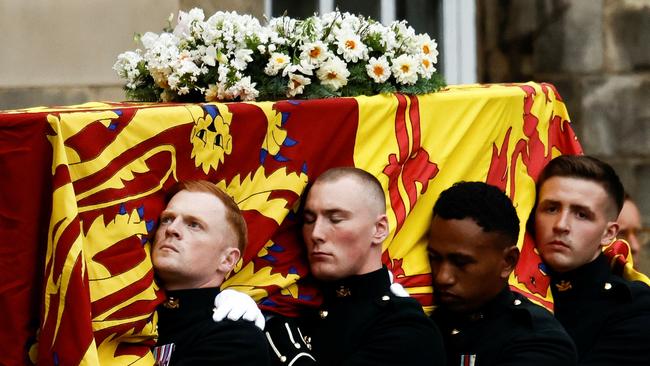Oak casket was made 30 years ago by a carpenter lost to time and takeover
A lead lining makes it extremely heavy, so on the day of the funeral it will be carried by eight military bearers.

When the Queen’s coffin appeared for the first time outside Balmoral Castle, few onlookers would have realised that the heavy oak casket was made for her more than 30 years ago.
Not even Leverton & Sons, the independent family firm of undertakers from north London that has worked closely with the royal household on the funeral arrangements, know who made it.
The firm was established in 1789, becoming undertakers to the royal family in 1991. They inherited the coffin made for the Queen by the previous firm of royal funeral directors, Kenyons.
“It is made from English oak, which is very difficult to get hold of,” Andrew Leverton, who runs the firm, said in an interview with The Times four years ago.
“Oak coffins are now made from American oak.
“I don’t think we could use English oak for a coffin now. It would be too expensive.”
It is lined with lead. As Mr Leverton said: “The burial will not be an earth burial, it is a crypt” — specifically, the crypt in the King George VI Memorial Chapel at St George’s Chapel, Windsor.
The lead lining makes it extremely heavy, so on the day of the funeral it will be carried by eight military bearers.
Most people do not have their coffin made decades before they die, but for the Queen, no one was taking any chances.
“It is not something you can just make in a day,” Mr Leverton said. “There are fitments on the coffin lid which allow the instruments of state to be fitted.”
During the funeral, the Imperial State Crown, the orb and the sceptre will be placed on the coffin. The brass fittings on the lid allow for all the regalia to be clipped in place so they do not fall off.
That is not an idle fear. During the funeral procession of George V in January 1936, as the cortege turned into New Palace Yard the Maltese Cross fell from the Crown and landed in the gutter.
“A most terrible omen,” wrote Harold Nicholson. He was not wrong: the greatest crisis in modern royal history took place later that year, with the abdication of George’s successor, Edward VIII.
The brass handles are of a special design used for royal coffins.
When the old ones needed replacing, Levertons had to get a company in Birmingham to make new ones, copied from the old fitments.
Despite being the royal funeral directors, there is nothing particularly grand about Levertons. They have six branches and perform just over 1000 funerals a year.
The founder was John Leverton, a carpenter who came to London from Devon, and set up a workshop in the Regent’s Park area. They have looked after the funerals of the writers George Orwell, Sylvia Plath, Joe Orton and Kingsley Amis; Sir Henry Royce of Rolls-Royce; politicians Michael Foot, Hugh Gaitskell and Enoch Powell; actors and performers Kenneth Williams, Max Wall, Dame Peggy Ashcroft, Dirk Bogarde, Peter O’Toole and Bob Hoskins; musicians Ronnie Scott and Ian Dury; designer Alexander McQueen; the Sex Pistols’ manager Malcolm McLaren and artist Lucian Freud.
The Times



To join the conversation, please log in. Don't have an account? Register
Join the conversation, you are commenting as Logout